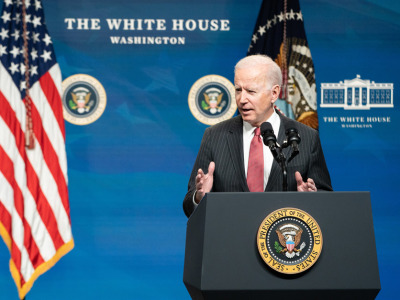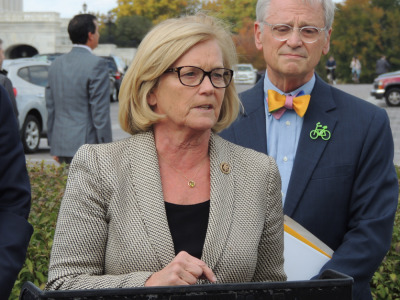House spending bills for fiscal 2022 are making climate action a priority both at home and abroad while also ramping up spending for enforcement of environmental regulations.
Agricultural research also would get a significant boost, but far less than what President Joe Biden proposed in his FY22 budget.
Programs aimed at promoting small-scale and local agriculture also are priorities for funding in the bills.
Ahead of the July 4 break, the House Appropriations Committee approved the first of its FY22 funding bills, including Agriculture, which funds the Agriculture Department and Food and Drug Administration; Interior-Environment, which funds the Interior Department and Environmental Protection Agency; and State-Foreign Operations, which funds the U.S. Agency for International Development, which handles international food assistance and agricultural development programs.
The full House will consider the bills later. The House spending bills will have to be reconciled with what the Senate eventually produces, but since both chambers are under Democratic control this year, the House priorities have a better chance of surviving the legislative process.
The 2022 budget year starts Oct. 1.
Here are some of the highlights of the FY22 bills.

President Joe Biden
AG RESEARCH
This is one area where the committee agreed to provide significant funding increases but at lower levels than the White House wants. USDA would get $3.4 billion for research, a $321 million increase over FY21. USDA’s in-house research work led by the Agricultural Research Service would get a $145 million increase to $1.64 billion, $212 million less than Biden wanted.
The National Institute of Food and Agriculture, which funds research through colleges and universities and other outside entities, would get a $69 million increase in FY22 to $992.6 million, an amount that is $317 million less than Biden wanted.
The Agriculture and Food Research Initiative, part of NIFA, is a competitive grants program that targets six research areas, including plant and animal health, food safety, agricultural systems and natural resources. It would get a $15 million increase to $450 million for 2022, well under the $700 million Biden requested.
A small NIFA program that is important to small-scale agriculture — Sustainable Agriculture Research and Education, or SARE — would get a $10 million increase to $50 million in FY22.
AG LENDING
Funding for direct farm ownership loans would be increased by $300 million to $2.8 billion in FY22. The bill provides $3.5 billion for guaranteed ownership loans, a $200 million increase over FY21.
Direct and guaranteed operating loans would be funded at $1.6 billion and $2.1 billion, the same amounts as FY21.
BIOFUELS
The committee report that accompanies the Interior-Environment spending bill prods EPA to act on a request to make renewable diesel and renewable jet fuel produced from canola oil through a hydrotreatment process eligible for the Renewable Fuel Standard.
Republicans on the Appropriations Committee were unsuccessful in redirecting the $25 million that is in the Interior-Environment bill for electric vehicles. Rep. Ashley Hinson, R-Iowa, proposed to have the money transferred to clean water grants, saying that "$25 million is a lot of money so bureaucrats can drive fancy cars." Rep. Chellie Pingree, D-Maine, defended the EV funding. "This does not mean everyone in government will drive a Tesla," she said.

Rep. Chellie Pingree, D-Maine
CHLORPYRIFOS
The Interior-Environment bill report provides support for a 9th U.S. Circuit Court of Appeals ruling that ordered EPA to revoke or modify tolerances for the insecticide chlorpyrifos.
“The Committee accepts the findings from numerous studies establishing the link between the use of chlorpyrifos and brain damage in children. The Agency is expected to meet its obligations to protect human health and the environment.” the report says.
CLIMATE
Various USDA programs and offices would get $347.4 million for climate-related work. According to the committee’s bill report, the funding will go to “new investments across USDA to focus on climate change research and assessment; measurement and monitoring; greenhouse gas emissions mitigation; carbon sequestration; and clean energy technologies.”
The State-Foreign Ops bill designates $1.6 billion for the UN’s Green Climate Fund, $350 million more than Biden requested. The Obama administration initially pledged $3 billion to the fund, which is designed to help people become more resilient to extreme weather and rising seas, but the Trump administration declined to put money into the initiative.
The bill report also directs USAID and the State Department to “include reforestation and grasslands restoration in the design and planning of environmental and food security activities” overseas.
CONSERVATION
The Agriculture bill fully funds USDA conservation programs at the levels mandated by the 2018 farm bill while increasing funding for staffing and other operations at the Natural Resources Conservation Service.
NRCS’ conservation operations would be funded at $894.7 million, including nearly $760 million for conservation technical assistance, according to an analysis by the National Sustainable Agriculture Coalition.
In FY21, NRCS got $832.7 million for conservation operations, including $734 million for technical assistance.
ENVIRONMENTAL ENFORCEMENT
EPA’s environmental programs would be funded at $3.4 billion under the House bill, a $603 million increase from FY21 and just $63 million below what Biden requested. Those programs include EPA’s regulatory enforcement work as well as “geographic” programs that fund initiatives to clean up and curb pollution in the Chesapeake Bay, Great Lakes and other areas.
Some $142 million would be earmarked for a new “environmental justice” program that is intended in part to ensure that the agency considers the impact on minority communities when issuing permits and taking other measures. The bill report directs EPA to develop a definition for "disproportionately exposed communities” and incorporate the definition into its environmental work. Concentrated animal feeding operations have in the past been accused of harming poor communities.
The Interior Department’s Fish and Wildlife Service would get $1.9 billion, a $301 million increase over FY21.
Interested in more coverage and insights? Receive a free month of Agri-Pulse West
LOCAL FOOD/ORGANIC
In addition to the increase for the SARE research program, there is higher funding for other programs that would benefit local agriculture and organic agriculture.
Funding for local food production through USDA Rural Development would be increased by $25 million to $100 million, enough to support $2 billion in loans. There is an additional $1 million set aside for local food hubs and $2 million for small meatpacking apprenticeships.
The Local Agriculture Market Program, a collection of initiatives, would be funded at $21.4 million to go with $100 million in coronavirus assistance provided by Congress in December and $50 million in additional funding that will be available in FY22.
The Farmers Market Nutrition Program, which is funded through the Women, Infants and Children nutrition assistance program, would be increased by $9 million to $30 million.
Funding for the National Organic Program, which overseas organic food standards, would be increased by $2 million to $20.3 million.
INTERNATIONAL AG
USAID would get $1.1 billion, the amount authorized by the Global Food Security Act, for agricultural development. The bill report encourages USAID to expand its Feed the Future initiative to additional countries. The program is currently operating in 12 target countries.
INTERNATIONAL FOOD AID
USDA's flagship food donation program, Food for Peace, would get $1.74 billion in FY22, the same amount as in FY21. Funding for the McGovern-Dole school feeding program would be increased $15 million to $245 million.
For more news, go to Agri-Pulse.com.


